China Renewable Energy Investment Market Outlook to 2029
By Energy Type (Solar, Wind, Hydro, Biomass, and Others), By Investment Type (Private and Public), By Regional Focus, By Key Players, and By Future Trends
- Product Code: TDR0100
- Region: Asia
- Published on: December 2024
- Total Pages: 110
Introducing the World's FirstPay-Per-Section Market Reports
Why pay for the full report when you need just a part?
Start Building Your Report
Scroll down to see available sections
Report Summary
The report titled “China Renewable Energy Investment Market Outlook to 2029 – By Energy Type (Solar, Wind, Hydro, Biomass, and Others), By Investment Type (Private and Public), By Regional Focus, By Key Players, and By Future Trends.” provides a comprehensive analysis of the renewable energy investment market in China. The report covers an overview and genesis of the industry, overall market size in terms of investment volume, market segmentation; trends and developments, regulatory landscape, investor profiling, issues and challenges, and comparative landscape including competition scenario, cross-comparison, opportunities, bottlenecks, and company profiling of major players in the renewable energy investment market. The report concludes with future market projections based on investment volume, energy type, region, and success case studies highlighting the major opportunities and cautions.
China Renewable Energy Investment Market Overview and Size
The China renewable energy investment market reached a valuation of CNY 1.5 trillion in 2023, driven by the government's ambitious carbon neutrality goals, technological advancements, and increasing global interest in sustainable energy solutions. The market is characterized by key players such as China Three Gorges Corporation, Goldwind, LONGi Green Energy Technology, Sungrow Power Supply, and Envision Group. These companies are recognized for their leadership in innovation, extensive project portfolios, and strategic partnerships.
In 2023, LONGi Green Energy Technology announced its new solar module production facility in Jiangsu Province, designed to meet growing domestic and international demand for high-efficiency solar panels. Regions like Jiangsu, Inner Mongolia, and Guangdong are key investment hubs due to their favorable policies, abundant renewable resources, and robust industrial ecosystems.
Market Size for China Renewable Energy Investment Market on the Basis of Investments in USD Billion, 2018-2024
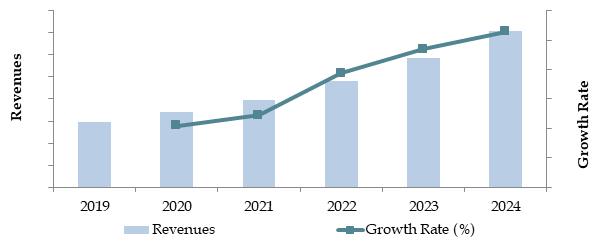
What Factors are Leading to the Growth of China Renewable Energy Investment Market?
Policy Support and Government Initiatives: The Chinese government’s commitment to achieving carbon neutrality by 2060 has driven extensive policy support for renewable energy investments. In 2023, subsidies, tax incentives, and favorable financing schemes contributed to approximately 70% of new renewable energy project launches. Policies such as feed-in tariffs and renewable portfolio standards have provided a stable environment for investors.
Technological Advancements: Continuous advancements in renewable energy technologies, such as more efficient solar panels, wind turbines, and energy storage systems, have significantly reduced costs. The levelized cost of electricity (LCOE) for solar energy, for example, has decreased by nearly 20% between 2020 and 2023, making renewables more competitive with traditional energy sources.
Foreign and Private Investment Growth: An influx of foreign direct investment (FDI) and increased participation of private players have enhanced the renewable energy landscape in China. In 2023, foreign investments in China’s renewable energy sector increased by 15% year-over-year, driven by attractive market opportunities and partnerships with local firms.
Which Industry Challenges Have Impacted the Growth of China Renewable Energy Investment Market?
Grid Infrastructure Limitations: Insufficient and outdated grid infrastructure remains a major bottleneck for the renewable energy sector. As of 2023, nearly 25% of renewable energy generated in remote areas of China faced curtailment due to inadequate grid capacity and connectivity issues, significantly reducing the efficiency of investments in wind and solar projects.
Regulatory Complexity: Navigating China’s complex regulatory framework poses challenges for both domestic and foreign investors. Regional variations in permitting processes and inconsistent enforcement of policies often result in project delays. In 2023, it was estimated that nearly 18% of planned renewable energy projects faced delays exceeding six months due to regulatory bottlenecks.
Land Use Conflicts: Securing land for large-scale renewable energy projects, particularly solar farms and wind parks, can be contentious. Competing demands for agricultural land and environmental concerns have led to disputes and project cancellations. In 2023, approximately 12% of renewable energy projects were delayed or scrapped due to unresolved land use issues.
What are the Regulations and Initiatives which have Governed the Market?
Renewable Energy Law: The Chinese government’s Renewable Energy Law, enacted in 2006 and updated periodically, provides the legal foundation for renewable energy development. It mandates grid companies to prioritize renewable energy integration and includes mechanisms like feed-in tariffs to ensure profitability for renewable energy producers. By 2023, over 85% of renewable energy projects benefitted from the law's provisions, accelerating the sector’s growth.
National Carbon Market: Launched in 2021, China’s national carbon trading market is a critical initiative to encourage renewable energy investments. The market allows companies to trade carbon credits, providing an economic incentive for industries to reduce emissions. In 2023, over 4.5 billion tons of carbon allowances were traded, indirectly boosting demand for clean energy projects.
13th and 14th Five-Year Plans: China's renewable energy goals are guided by its five-year plans, with the 14th plan (2021-2025) setting ambitious targets for wind, solar, and biomass energy capacity. By 2023, the cumulative installed capacity of renewable energy surpassed 1,300 GW, largely driven by these centralized development goals.
China Renewable Energy Investment Market Segmentation
By Market Structure: State-owned enterprises (SOEs) dominate China's renewable energy market due to their financial strength, government backing, and large-scale project capabilities. These entities, such as China Energy Investment Corporation and State Power Investment Corporation, account for a significant portion of investments in large-scale solar, wind, and hydropower projects. Private companies and foreign investors are also gaining market share, focusing on niche segments like rooftop solar installations and innovative energy storage solutions.
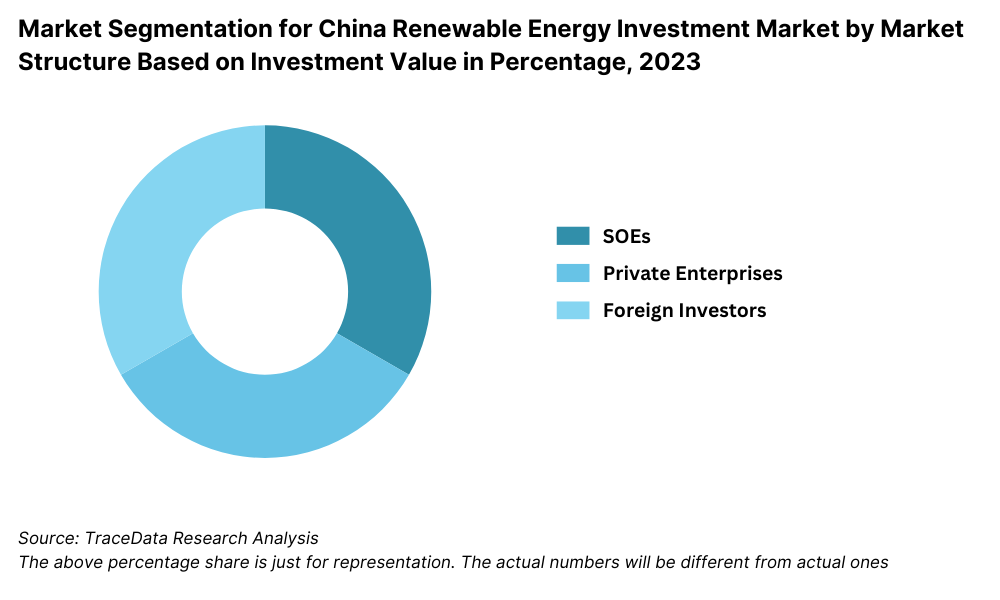
By Energy Type: Solar power holds the largest share of renewable energy investments in China, driven by declining costs and government incentives such as feed-in tariffs. Wind power, particularly offshore wind, is the second-largest segment due to advancements in technology and China’s extensive coastline. Biomass and hydropower account for smaller shares, catering to regional energy needs and industries requiring consistent baseload power.
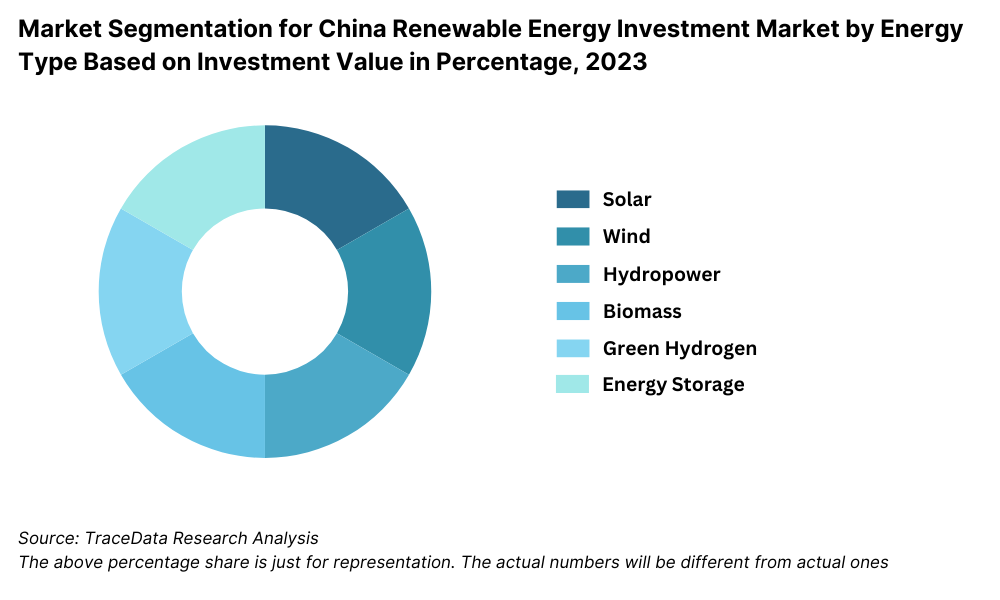
By Region: Investments are concentrated in provinces with abundant renewable energy resources and supportive policies. The Inner Mongolia and Xinjiang regions lead in wind energy investments due to favorable climatic conditions, while Guangdong and Jiangsu are prominent for solar and offshore wind projects. Coastal regions account for a significant share due to their focus on offshore wind development and energy demand from urban centers.
Competitive Landscape in China Renewable Energy Investment Market
The China renewable energy investment market is dominated by major state-owned enterprises, but private companies and international players are increasingly shaping the competitive landscape. Companies such as China Energy Investment Corporation (CEIC), State Power Investment Corporation (SPIC), Longi Green Energy Technology, China Three Gorges Corporation, and Sungrow Power Supply Co. lead the sector, leveraging scale, technology, and government support.
Company Name | Establishment Year | Headquarters |
|---|---|---|
China Energy Investment Corporation | 2017 | Beijing, China |
China Huaneng Group | 1985 | Beijing, China |
China Datang Corporation | 2002 | Beijing, China |
China Huadian Corporation | 2002 | Beijing, China |
State Power Investment Corporation (SPIC) | 2015 | Beijing, China |
China Three Gorges Corporation | 1993 | Beijing, China |
China Longyuan Power Group Limited | 1993 | Beijing, China |
China General Nuclear Power Group (CGN) | 1994 | Shenzhen, China |
China National Nuclear Corporation (CNNC) | 1955 | Beijing, China |
Goldwind Science & Technology Co., Ltd. | 1998 | Urumqi, Xinjiang, China |
Some of the recent competitor trends and key information about competitors include:
China Energy Investment Corporation (CEIC): CEIC remains a market leader, particularly in wind and solar energy projects. In 2023, the company reported the commissioning of over 3 GW of new wind power capacity, maintaining its position as a renewable energy giant.
State Power Investment Corporation (SPIC): SPIC has been instrumental in developing offshore wind projects. In 2023, it completed China's largest offshore wind farm in Jiangsu Province, with a capacity of 1 GW. This milestone strengthens its leadership in the sector.
Longi Green Energy Technology: Longi, a global leader in solar manufacturing, achieved record-breaking sales of photovoltaic modules in 2023, exporting over 50 GW globally. The company continues to invest heavily in research and development, making it a key player in China's solar power industry.
China Three Gorges Corporation: Renowned for its expertise in hydropower, China Three Gorges Corporation has diversified into solar and wind. In 2023, it launched a major solar-wind hybrid project in Inner Mongolia, showcasing its innovative approach to renewable energy.
Sungrow Power Supply Co.: Sungrow is a leading inverter supplier in China and globally. In 2023, the company reported a 30% increase in sales of energy storage systems, driven by rising demand for grid stabilization solutions. Its robust export performance also highlights its international competitiveness.
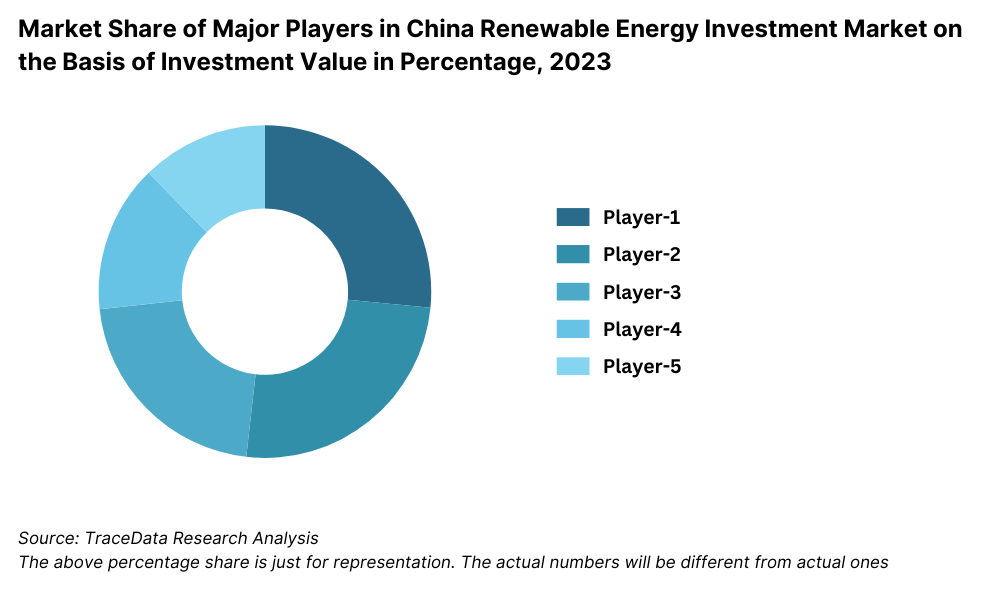
What Lies Ahead for China Renewable Energy Investment Market?
The China renewable energy investment market is poised for robust growth by 2029, with a strong CAGR projected over the forecast period. This growth will be driven by technological advancements, supportive government policies, and increasing international collaborations to meet ambitious carbon neutrality goals.
Accelerated Transition to Solar and Offshore Wind Power: Solar and offshore wind energy are expected to remain the dominant focus areas for investments. Technological breakthroughs in photovoltaics and offshore wind turbine efficiency will continue to lower costs, making these options more competitive with traditional energy sources. By 2029, China is projected to add over 500 GW of new capacity in these sectors.
Expansion of Energy Storage Systems: The growth of energy storage solutions, including batteries and advanced grid technologies, is anticipated to address the challenges of renewable energy intermittency. Government initiatives to establish large-scale energy storage facilities will not only stabilize the grid but also encourage greater investment in renewable projects.
Increased International Partnerships: China’s role as a global leader in renewable energy is likely to attract more international collaborations. Joint ventures and technology-sharing agreements with countries in Europe, Asia, and Africa will contribute to knowledge exchange and open new markets for Chinese renewable energy technologies.
Focus on Green Hydrogen Development: The market is witnessing a growing interest in green hydrogen as a complementary renewable energy source. Investments in hydrogen production facilities, particularly powered by solar and wind energy, are expected to grow significantly by 2029, aligning with China's goal to lead the global hydrogen economy.
Future Outlook and Projections for China Renewable Energy Investment Market on the Basis of Investment Value in USD Billion, 2024-2029
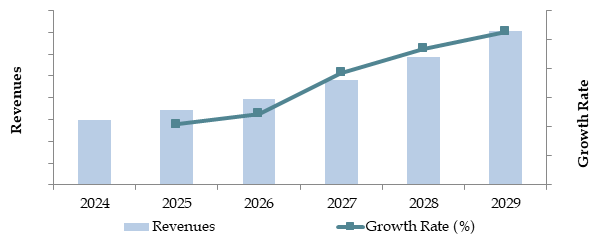
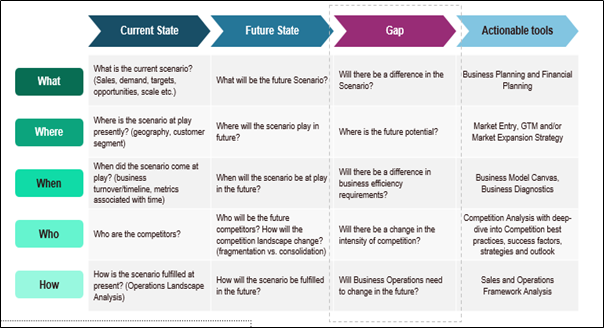
China Renewable Energy Investment Market Segmentation
By Market Structure:
State-Owned Enterprises (SOEs)
Private Enterprises
Foreign Investors
Public-Private Partnerships (PPPs)
Regional Development Projects
By Energy Type:
Solar Energy
Wind Energy (Onshore and Offshore)
Hydropower
Biomass Energy
Green Hydrogen
Energy Storage Systems
By Source of Investment:
Domestic Investments
Foreign Direct Investments (FDIs)
Green Bonds and Sustainable Financing
Institutional Investments
Crowdfunding and Community Financing
By Region:
Northern China
Eastern China
Southern China
Western China
Central China
Coastal Regions
By Scale of Projects:
Large-Scale Utility Projects
Medium-Sized Regional Projects
Small-Scale Community Projects
Players Mentioned in the Report:
China Energy Investment Corporation (CEIC)
State Power Investment Corporation (SPIC)
Longi Green Energy Technology
China Three Gorges Corporation
Sungrow Power Supply Co.
Goldwind
Envision Energy
Trina Solar
JinkoSolar
Key Target Audience:
Renewable Energy Developers
Energy Financing Institutions
Government and Regulatory Bodies (e.g., National Energy Administration)
Technology Providers and Equipment Manufacturers
Research and Development Institutions
Time Period:
Historical Period: 2018–2023
Base Year: 2024
Forecast Period: 2024–2029
Report Coverage
Choose individual sections to purchase. Mix and match as you like.
- -
- -
- $100
4.1. Value Chain Process-Role of Entities, Stakeholders, and Challenges They Face
4.2. Revenue Streams for China Renewable Energy Investment Market
4.3. Business Model Canvas for China Renewable Energy Market
4.4. Investment Decision-Making Process
4.5. Policy Influence on Investment Decisions
$2505.1. Installed Renewable Energy Capacity in China, 2018-2024
5.2. Energy Mix Analysis in China, 2018-2024
5.3. Renewable Energy Investments vs. Fossil Fuel Investments, 2023-2024
5.4. Regional Distribution of Renewable Energy Projects in China, 2024
$150- $100
- $200
8.1. Investment Value, 2018-2024
8.2. Revenues, 2018-2024
8.3. Renewable Energy Capacity Addition, 2018-2024
$3009.1. By Energy Type (Solar, Wind, Hydropower, Biomass, Green Hydrogen, Energy Storage), 2023-2024
9.2. By Market Structure (SOEs, Private Enterprises, Foreign Investors), 2023-2024P
9.3. By Region (Northern, Eastern, Southern, Western, Central, Coastal), 2023-2024P
9.4. By Scale of Projects (Utility, Medium-Scale, Small-Scale), 2023-2024P
9.5. By Source of Investment (Domestic, FDI, Green Bonds), 2023-2024P
$40010.1. Stakeholder Landscape and Cohort Analysis
10.2. Investment Journey and Decision-Making Factors
10.3. Investor Needs, Drivers, and Barriers
10.4. Gap Analysis Framework
$50011.1. Trends and Developments in China Renewable Energy Investment Market
11.2. Growth Drivers for China Renewable Energy Investment Market
11.3. SWOT Analysis for China Renewable Energy Investment Market
11.4. Challenges and Bottlenecks in the Market
11.5. Regulatory Landscape for China Renewable Energy Market
$20012.1. Market Size and Potential for Offshore Wind Energy Market, 2018-2029
12.2. Business Models and Revenue Streams in Offshore Wind
12.3. Cross-Comparison of Key Offshore Players by Capacity, Revenue, and Projects
$50013.1. Green Finance Penetration Rates and Trends, 2018-2029
13.2. Key Financing Instruments for Renewable Energy Projects
13.3. Role of Green Bonds in Driving Renewable Energy Investments
13.4. Financing Split by Type of Entity (SOEs, Private, International), 2023-2024P
13.5. Average Project Financing Structures and Terms in China
13.6. Finance Disbursements for Renewable Energy in China, 2018-2024P
$300- $250
- $150
16.1. Market Share of Key Players in China Renewable Energy Investment Market, 2023
16.2. Benchmarking of Key Competitors in China Renewable Energy Market Based on Operational and Financial Indicators
16.3. Strengths and Weaknesses of Key Players
16.4. Operating Model Analysis Framework
16.5. Comparative Strategies Using Gartner Magic Quadrant
16.6. Bowmans Strategic Clock for Competitive Advantage
$75017.1. Investment Value, 2025-2029
17.2. Revenues, 2025-2029
17.3. Renewable Energy Capacity Addition, 2025-2029
$30018.1. By Energy Type (Solar, Wind, Hydropower, Biomass, Green Hydrogen, Energy Storage), 2025-2029
18.2. By Market Structure (SOEs, Private Enterprises, Foreign Investors), 2025-2029
18.3. By Region (Northern, Eastern, Southern, Western, Central, Coastal), 2025-2029
18.4. By Scale of Projects (Utility, Medium-Scale, Small-Scale), 2025-2029
18.5. By Source of Investment (Domestic, FDI, Green Bonds), 2025-2029
$400- $250
- $250
Research Methodology
Step 1: Ecosystem Creation
Map the ecosystem and identify all the demand-side and supply-side entities in the China Renewable Energy Investment Market. Based on this mapping, we shortlist leading 5–6 players in the market, considering their financial performance, project capacity, and scope of operations.
Sourcing is conducted through industry reports, government publications, and proprietary databases to compile a comprehensive desk research framework that captures industry-level insights.
Step 2: Desk Research
A rigorous desk research process is undertaken, referencing a variety of secondary and proprietary databases. This stage involves collecting and analyzing data on market size, investment flows, key players, and technological trends.
The analysis focuses on critical market variables, including project capacities, investment value, policy impacts, and growth trajectories. This is supplemented by an in-depth review of company-level information, leveraging annual reports, press releases, financial statements, and other publicly available data sources.
The primary objective is to develop a solid foundational understanding of the market and the ecosystem.
Step 3: Primary Research
Conduct in-depth interviews with C-level executives, project developers, financiers, and other stakeholders representing companies and institutions in the China Renewable Energy Investment Market.
These interviews aim to validate secondary research findings, refine market hypotheses, and gather qualitative insights into investment strategies, challenges, and opportunities.
A bottom-up approach is used to estimate the market size and volume of investments, aggregated to reflect the broader market landscape.
Disguised interviews are conducted with companies, approached as potential investors or partners. This technique validates operational and financial data provided by executives and cross-verifies findings with secondary sources, offering a more accurate and nuanced understanding of market dynamics.
Step 4: Sanity Check
A thorough top-down and bottom-up analysis is employed, followed by market size modeling exercises to ensure accuracy and consistency.
- The sanity check process involves reconciling findings from desk and primary research to validate the reliability and credibility of the final insights.
FAQs
1. What is the potential for the China Renewable Energy Investment Market?
The China Renewable Energy Investment Market is projected to grow significantly, reaching a valuation of over USD 300 billion by 2029. This growth is driven by the nation's ambitious carbon neutrality goals, strong government support, and advancements in renewable energy technologies. The market's potential is further enhanced by China's leadership in global renewable energy deployment and innovation.
2. Who are the Key Players in the China Renewable Energy Investment Market?
The China Renewable Energy Investment Market is dominated by major players such as China Energy Investment Corporation (CEIC), State Power Investment Corporation (SPIC), and Longi Green Energy Technology. Other key contributors include China Three Gorges Corporation, Sungrow Power Supply Co., Goldwind, and Trina Solar. These organizations lead the market due to their technological expertise, large-scale project capabilities, and strong financial backing.
3. What are the Growth Drivers for the China Renewable Energy Investment Market?
Key growth drivers include the Chinese government's commitment to carbon neutrality by 2060, extensive policy support through subsidies and incentives, and technological advancements that have lowered the cost of renewable energy. Additionally, the increasing demand for clean energy due to urbanization and industrial growth, coupled with international collaboration and foreign investments, contributes to market expansion.
4. What are the Challenges in the China Renewable Energy Investment Market?
The market faces challenges such as inadequate grid infrastructure to support renewable energy integration, regulatory complexities causing project delays, and competition for land use. Dependence on raw materials like rare earth metals and polysilicon also creates supply chain vulnerabilities. Moreover, smaller and community-level projects often struggle to secure financing, limiting localized energy transitions.